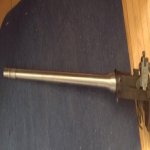Recently on the EE I picked myself up a 308 Lee Enfield barrel, which has had me a bit perplexed and in search of some answers.
The barrel is "In the White" and has no markings on it, other than what looked like an engraver mark on the butt-end of the nox, labeled "308".
Installed fine, and some test-fires performed well (IE it didn't blow up in my face).
The front end of the barrel however has given me some problems.. The bayonet lugs are too large to fit the front site on (not to mention a bayonet), and there's no cross-file for the sight pin. I was hoping someone might have some information on who might have made this barrel ( I have been informed DCRA barrels did not have lugs), and what's my best course of action to get this rifle front-sighted.
-Thanks

The barrel is "In the White" and has no markings on it, other than what looked like an engraver mark on the butt-end of the nox, labeled "308".
Installed fine, and some test-fires performed well (IE it didn't blow up in my face).
The front end of the barrel however has given me some problems.. The bayonet lugs are too large to fit the front site on (not to mention a bayonet), and there's no cross-file for the sight pin. I was hoping someone might have some information on who might have made this barrel ( I have been informed DCRA barrels did not have lugs), and what's my best course of action to get this rifle front-sighted.
-Thanks








































































